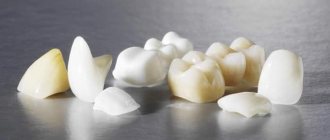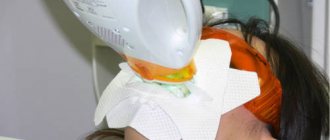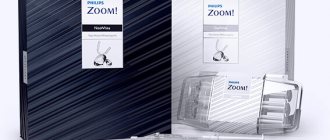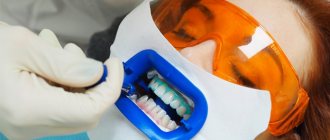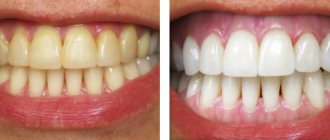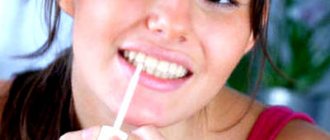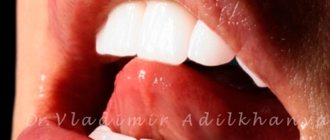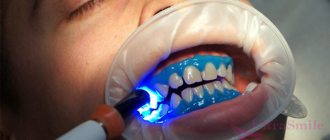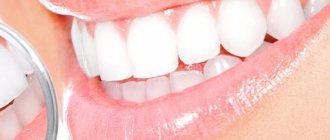Today, teeth whitening is considered an affordable procedure that will help make your smile even more beautiful. And indeed it is. Therefore, in the absence of contraindications, there are no arguments against whitening. It's safe, comfortable and fast. We offer patients a choice of several effective whitening systems:
- Amazing White,
- Opalescence,
- Zoom 4,
- Klox,
- Philips Zoom QuickPro.
Next we will look at each of them in detail.
When going to the clinic, you should be prepared for the fact that not everyone recommends teeth whitening using one of the popular methods. There are situations when uneven teeth, the presence of fillings in the smile area, a specific natural shade of enamel or other nuances will not give the maximum result after whitening procedures. Sometimes the doctor will recommend other methods: whitening pen, trays or strips. You can find out about the presence of contraindications, as well as get advice on choosing the optimal system, during a consultation with our dental hygienist.
How is the procedure done?
We use only safe enamel lightening techniques. All systems presented in the clinic are based on the mild, effective effects of special gels. They contain hydrogen peroxide of varying concentrations, which penetrates the tooth tissue and neutralizes pigment. Whatever system you choose, you should not be afraid of harm to your health and enamel. The only possible consequence of some systems is a short-term increase in sensitivity.
Teeth whitening begins with a consultation. The doctor examines the oral cavity, assesses the condition of the teeth and enamel, notes the presence of fillings and crowns in the smile area - this is the area that is used during whitening. Chewing teeth and enamel on the inside do not whiten.
Important: if you have caries or gum inflammation, as well as other problems in the oral cavity, this is where you should start. Any whitening procedure can only be performed on healthy teeth.
If during the consultation the doctor identifies contraindications (we’ll talk about them later), then you will be offered alternative ways to whiten your teeth at home. For such independent procedures, special products are produced, the concentration of substances in which is significantly lower than in the products for the procedure in the clinic. This should be understood so as not to expect instant results from pencils, trays or strips.
If the oral cavity is healthy and there are no contraindications, the doctor will offer several systems to choose from and tell you how they work. Our clinic offers technologies that require exposure to lamp light, as well as those that work without lamps.
Which whitening to choose at home?
There are many whitening products available on the modern market that allow you to carry out the procedure without leaving your home. They differ in price category, effectiveness, safety, possible risks and other characteristics. These are various pastes, plates, mouth guards, as well as compositions prepared independently from improvised means.
It is difficult to say which method will be most effective. However, even the most expensive pharmaceutical preparations for home use will not show the same effect as dental intervention in a clinic.
Having considered what types of professional teeth whitening in dentistry exist, you can choose a technique that is right for you. We invite you to sign up for a preliminary consultation with a Dentiki dentist by calling the number listed on the website or filling out the feedback form.
Types of teeth whitening
Most clinics in the world offer basic types of teeth whitening, which have proven to be effective and safe. Let's look at their operating principle and differences. To begin with, here are examples of systems that require exposure to lamp light:
Zoom
One of the oldest systems offers a 15% peroxide-based gel that enhances the light from the lamp. There are several generations of this system. The result varies from 8 to 12 shades.
Amazing White
This affordable technology provides 6–10 shades of lightening. Here, a gel based on hydrogen peroxide (16% or 24%) is used, which is applied to the enamel and dried under the light of a lamp. After this, the enamel is remineralized to eliminate hypersensitivity.
Klox
A system that appeared not so long ago and quickly gained popularity. The procedure takes only 30 minutes and whitens by 8 tones using a 39% concentration gel. After this procedure, the sensitivity of the enamel almost never increases.
There are no less effective systems that work without a lamp:
Zoom QuickPro
We follow the developments in the world of dentistry and are attentive to innovation. Therefore, quite recently, a new method has appeared on the clinic’s list of “whitening” services, which does not require exposure to lamp light. This is teeth whitening using the Zoom QuickPro express method from Philips. The method involves applying special products to the enamel in two layers. First it is a varnish based on 20% hydrogen peroxide. Immediately after application, the varnish is covered with a sealant, which dries immediately. This is a safe and very fast procedure. Just 10 minutes - and you are free! 30 minutes after application, you will simply need to remove the varnish using a napkin or regular brushing of your teeth.
Opalescence Boost
This is one of the oldest systems that stood at the origins of whitening throughout the world. It uses a gel based on hydrogen peroxide (40%), enriched with preventive components that will help protect teeth from caries. The procedure involves 3 stages of applying and drying the gel, each of which lasts 20 minutes. The Opalescence Boost system also includes at-home whitening trays, which the patient can choose to use.
What is Zoom-4
Whitening Zoom-4 is a cosmetic procedure for lightening tooth enamel by exposing it to chemical ingredients. The technique is an improved version of the Zoom-3 technology. Its advantage is a more gentle effect on the teeth (the top layer is not destroyed) and a reduced process time. The main active element that penetrates the enamel and discolors it is hydrogen peroxide, more precisely, one of its forms is carbamide peroxide. Standard concentration is 25%. It is safe and has no harmful effects on the body (when used externally).
During the procedure, the dentist uses a special lamp to activate a chemical reaction. This lamp has the option of regulating the light flow modes. The doctor can choose the optimal one for the conditions of a particular clinical case in order to increase the comfort of the process for the patient. Under the influence of radiation, atomic oxygen is released from hydrogen and penetrates the pores of tooth enamel, destroying pigment cells by an oxidative cleavage reaction.
Important: dentists recommend that patients with serious discoloration of teeth use not only clinical whitening, but also supplement it with home whitening. The doctor gives out a dental guard and chemical reagents in syringe tubes, and talks about the sequence of actions. The intensity of home manipulations is weaker, so the risk of accidental chemicals. burns are excluded if the given recommendations are followed.
Contraindications to teeth whitening
Here is a list of contraindications to teeth whitening:
- caries,
- severe tooth sensitivity,
- tartar,
- increased sensitivity to UV rays (for systems that use lamp light),
- age up to 18 years,
- pregnancy.
You can easily remove contraindications such as caries and tartar with preliminary dental treatment. If you have a high natural sensitivity, the whitening procedure will briefly enhance the sensations.
Please note that if your teeth are uneven and there are fillings in the smile area, your doctor will most likely recommend whitening your teeth at home. We do not carry out procedures that will not bring results. Therefore, if there are obvious risks of a lack of whitening effect, the hygienist will immediately tell the patient about this and offer an alternative.
Professional cleaning
Cleaning your teeth from plaque and hard deposits will return them to a healthy natural color, which, of course, will not be white, but definitely a tone or two lighter than without cleaning. In addition, such hygiene is very good for health. It reduces the risk of caries and other diseases. WHO recommends cleaning once or twice a year.
The most popular and effective methods:
- Airflow - plaque is removed using a special device that delivers a solution with crushed abrasive under pressure. This allows you to eliminate dark plaque that occurs due to consumption of coffee, tea, soda and other coloring foods, as well as due to exposure to cigarette smoke. As a result, the natural color of the teeth returns. This procedure can also serve as a preparatory step for cosmetic whitening.
- Ultrasonic cleaning is performed by a device (scaler) that generates ultrasonic vibrations that affect the enamel surface. This method can get rid of not only staining plaque, but also tartar. The procedure is completely safe.
Prices and effectiveness of teeth whitening in Krasnoyarsk
When you are faced with studying this issue for the first time, the promise of a result of 6-10 shades seems incredible. Usually patients think that this is a lot and just enough to make snow-white teeth out of “ordinary” teeth. But it is not so.
The Vita scale, which shows the main shades of enamel, can be easily found on the Internet. On it you will see that the difference between them is insignificant. Therefore, a whitening efficiency of 6–10 positions will obviously not produce Hollywood whiteness. However, repeated treatment and attention to dental hygiene will significantly lighten the enamel, even out the tone of all teeth and give a natural, clean glow to your smile.
Indications and contraindications of the method
The procedure is used to whiten the enamel by several tones. This may be required in several cases:
- if desired, add additional whiteness to your smile;
- with the formation of pigmented plaque from smoking;
- with pigmentation from taking tetracycline antibiotics;
- after a course of orthodontic correction with braces.
Despite its safety, lightening the enamel surface of the teeth using the ZOOM-4 method cannot always be carried out. The following prohibitions exist:
- children's age (up to 16 years);
- pregnancy and breastfeeding;
- oncology;
- dental diseases;
- periodontal disease in the acute stage;
- exposure of the roots of dental elements;
- a course of antibiotics and regular use of oral contraceptive pills;
- mental illnesses;
- allergy to the components of the chemical complex.
Before the procedure, the dentist conducts a visual examination and collects anamnesis regarding existing contraindications. After analyzing the list above, we can conclude that some prohibitions are temporary. So, if you have problems with your teeth, it is enough to eliminate them. Then you can perform bleaching. The same applies to a course of antibacterial therapy or taking contraceptives. If there are absolute contraindications, the patient will have to abandon the idea of chemical lightening. But don’t be upset, the enamel can be lightened a couple of tones using the Air Flow hardware cleansing method.
.
I want to whiten my teeth: what should I do?
Whitening, which is prescribed by the doctor during consultation, will be effective. In this case, the result will be individual for each patient. In addition, the visual perception of tooth color is always influenced by lighting, skin color and even the color of clothing.
Teeth whitening can be considered a safe way to improve your quality of life. You will be pleased with the reflection in the mirror, and you will no longer have to hide your smile. Healthy teeth without excess pigmentation look well-groomed and white, even if their natural shade is far from perfect white.
The cost of whitening in our clinic starts from 8,000 rubles without discount. We often hold promotions with good discounts on this procedure, so you have a great chance to evaluate the results of any system.
AirFlow is not whitening
AirFlow is a technique that involves abrasively cleaning units. Some people think that it is aimed at lightening the enamel. In fact, this is not true. This is a standard hygiene procedure used to remove soft plaque and hardened tartar.
Since crowns are thoroughly cleaned during an AirFlow session, their appearance becomes much more aesthetically pleasing. However, there is no harm to oral health. Dentists recommend undergoing professional hygiene every year. This will keep your teeth and gums in good condition and reduce the likelihood of cavities forming.
What sensations can you expect from the procedure?
During whitening, there is most often no sensation, but mild discomfort and tingling may occur. The sensations depend on several factors: the thickness of the enamel, the presence of cracks in the enamel, and tooth hypersensitivity. If you know that your teeth are hypersensitive, then two weeks before whitening you need to undergo a course of remotherapy (a procedure that normalizes the mineral composition of tooth enamel) and repeat it for two weeks after.
How doctors whiten teeth
Conventionally, the entire process can be divided into successive stages:
- The doctor carefully examines the oral cavity and determines whether there are any dental diseases. If they are diagnosed, they are pretreated. Professional hygiene is mandatory. It cleanses the enamel and makes it more receptive to the lightening agent.
- Upon completion of preparation, the doctor isolates the mucous membranes of the mouth so that aggressive drugs do not come into contact with them. Then coats the teeth with gel. If necessary, he directs a lamp at them (in this case, the patient wears special safety glasses). You have to wait about fifteen or twenty minutes. Then the product is removed and the primary result is assessed. Afterwards the procedure is repeated again. In just one visit to the dental clinic, there may be two or three such repetitions - more is undesirable, since then the harm of teeth whitening will increase.
- Immediately after therapy, the dentition is treated with a strengthening remineralizing composition. It is needed to avoid increased tooth sensitivity.
It is important to agree with your doctor on the conventions. By holding the mouthguard in the mouth, the patient will not be able to tell if he is experiencing pain or other discomfort. Therefore, signs should be invented . For example, a wave of the left hand may indicate pain symptoms, while a nod of the head may indicate that everything is in order.
The patient should be aware that a slight tingling sensation in the area of the treated units is normal. But severe pain should not appear. If it occurs, under no circumstances should you wait until the end of the session. Sacrificing dental health for aesthetics is, to say the least, unwise. After all, you will then have to undergo a long recovery.
How safe is chemical bleaching?
Chemical bleaching is completely safe for the patient’s health. This is possible thanks to the use of high-tech equipment and modern bleaching agents that do not provoke negative reactions from the human body. For the procedure to be effective, it must be performed by an experienced dentist in a specialized, trustworthy clinic. Also, you should not have any contraindications for carrying out any manipulations to lighten dental tissues. Following all doctor’s recommendations, regular consultations and careful oral care will give you a radiant smile and keep it white for a long time.
Does the procedure have any contraindications?
As with any manipulation in the dental chair, there are contraindications, but not many of them:
- pregnancy and breastfeeding;
- oncological diseases;
- allergies to the drugs used.
All other problems - caries, inflammation of the oral mucosa and gums - are considered relative contraindications. After they are eliminated, bleaching can be done.
Even if you take good care of your teeth, whitening will have the effect of making your smile even more aesthetically pleasing.
